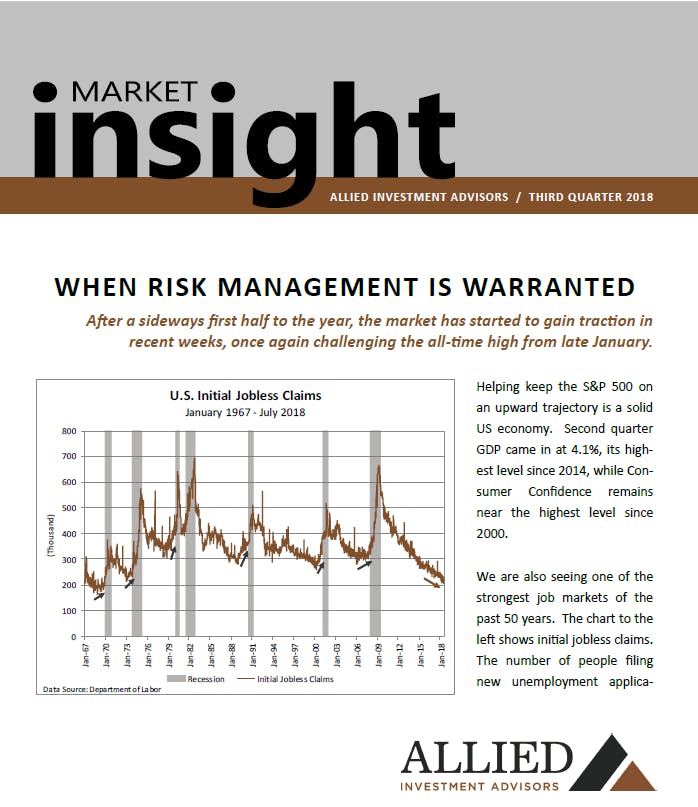Q3 2018: When Risk Management is Warranted
August 14, 2018
After a sideways first half to the year, the market has started to gain traction in recent weeks, once again challenging the all-time high from late January.
Helping keep the S&P 500 on an upward trajectory is a solid US economy. Second quarter GDP came in at 4.1%, its highest level since 2014, while Consumer Confidence remains near the highest level since 2000.
We are also seeing one of the strongest job markets of the past 50 years. The chart below shows initial jobless claims. The number of people filing new unemployment applications is at the lowest level since 1969. Historically, the economy has never gone into a recession with initial jobless claims hitting new lows.

Even with the strong economy, there are still issues to watch. The second quarter GDP gain may have been a pull forward of international trade before tariffs hit, causing growth to slow in coming months. Rising inflation pressures may trigger the Federal Reserve to be overly aggressive in raising interest rates, pushing the economy towards a slowdown. And the upcoming midterm elections and geopolitical issues remain wild cards.
Historically, the biggest investing tailwind has been staying the course. In the post-World War II era, the S&P 500 has grown at a compound rate of 7.2% per year (without accounting for dividends). There have been great times to buy (Oct. 1974, Mar. 2009) and there have been less attractive times (Mar. 2000), but overall, it has paid to be invested.
In investing, though, you have to be able to survive the journey to make it to the destination. Often, the best way to capture the market’s long-term gains is with a portfolio built for a smoother ride and lower volatility — a strategy focused on valuations, economic trends, and sector weightings.
In past economic cycles, different sectors have performed better at different stages. The more economically sensitive sectors – like Technology and Consumer Discretionary – have performed well in the early innings of an economic cycle. Industrial stocks often take a while to recover from a downturn, but by the middle of an economic expansion they are hitting their stride. Energy is often even later, waiting for inflation pressures to drive oil and gas prices higher, allowing them to outperform in a late expansion. Finally, Health Care, Consumer Staples, and Utilities all see relative outperformance late in an expansion and into a contraction as they provide core services that are required even when times get tough.
As this economic expansion ages, we have lowered our exposure to Technology by selling the Vanguard Technology ETF (VGT) and what we view to be appreciated Industrial and Technology stocks.

We have been rotating the proceeds from these sales into Health Care and Consumer Staples holdings. Not only do these two sectors historically perform well late in an economic cycle, but over the past 20 years they have been among the best performing in the S&P 500. Even with a more defensive nature, they have outperformed their more cyclical peers over full market cycles. While we may have been early in this rotation, we view it as a solid risk management move.
Our goal with these and other adjustments is to take a more conservative stance than the general market. The chart below shows the S&P 500 and a “Risk Management” approach. The Risk Management approach assumes capturing 90% of the S&P 500’s gain in bull markets, and 80% of the downside during bear markets. This more conservative philosophy (underperforming during the expansion but outperforming during the contraction) would have produced an outperformance of 57 percentage points since 2000, equivalent to an extra $285,000 in profit on a $500,000 investment. Not only has it outperformed, but it has done so with a smoother, less volatile ride.

In today’s economic environment, we believe a risk management approach is warranted. The economy looks healthy, with strong growth and low unemployment. However, at over 9 years old this bull market is no spring chicken, and rising inflation and a tightening Fed are often associated with a late cycle. A more defensive tilt, along with high-quality investments, provides a very conservative stance given the economic evidence.

